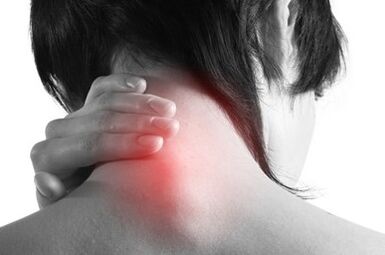
Osteochondrosis is a defeat of intervertebral discs of a degenerative dyeing nature and the cervical region is the most vulnerable part of the spinal column, which has an anatomically different structure of other vertebrae and weak muscle corset.Therefore, even with small additional loads on the neck, the vertebrae of the vertebrae can occur, leading to squeezing blood vessels and nerves.
And since the vertebral arteries involved in the influx of blood to the brain cross the holes in the transversal processes of the vertebrae in this department, the impressions of the vertebrae in this department or squeezing holes with invaded osteophytes are full of very serious consequences.
What is it?
Osteochondrosis of the cervical region is a progressive polyiethological disease that occurs through degeneration of the intervertebral discs and the dystrophy of the binding system of the spine.
Causes
The main causes and prerequisites for the occurrence of the osteochondosis of the cervical vertebra are:
- Vertebral column, scoliosis.
- Stress, nervous stress negatively influence the general state of the body, can cause cervical osteochondrosis.
- Infectious diseases often become the main cause.
- The wrong and uncomfortable position of the body during sleep (for example, an uncomfortable pillow).
- Congenital problems or the presence of hereditary diseases of the cervical column.
- Violation of the posture in young and adolescence.
- Excess weight, obesity of different degrees.The extra kilos increase the load on the vertebrae and discs, which leads to degenerative processes.
- Back injuries, which may have occurred in childhood or adolescence.
- Violation of metabolic processes.
- Work relating to physical work, which can cause spine diseases in different departments.
- Economic lifestyle, seated work, improper performance of any exercise.
For the successful treatment of osteochondosis of the cervical region, it is first necessary to establish the cause of the occurrence, the prerequisites that have caused its development and eliminate them.Until recently, the disease was found only in people of 45 years old.Now young people are subject to her, the age group is 18-25 years old.
Characteristics of the cervical region
Consider how the cervical region differs from the rest of the spine and that in the process of development of osteochondosis, acts as a prerequisite for the development of these syndromes.
- In the cervical region there are important ganglia (nodes) of the autonomous nervous system.
- In the transversal processes of the vertebrae, there are holes that form a canal through which the vertebral artery passes that provides oxygen and nutrients the brain, the cerebellum, the hearing organs and the vertebral nerve.These are the prerequisites for frequent clamps of artery and nerve.
- The cervical column is the most mobile.It is characterized by all types of movements in full.These are prerequisites for frequent infringements and sublussations.
- The intervertebral holes of the three lower vertebrae are not round, but a triangular shape.These are prerequisites for the violation of the nerve roots with bone growths that form with osteochondrosis.
- The intervertebral discs are located among the vertebral bodies not for everything.In front of them, there are protruding edges of the vertebrae, which are interconnected from the joints.These are the prerequisites for the emergence of the subluxation of the joints.
Development phase
The degree of osteocondrosis is determined by the clinical picture and the patient's complaints.The concept of degree should not be confused with the phases of the osteocondrosis.The phases will be discussed below.
- The first degree.Clinical manifestations are minimal, the patient can complain of pain in the low intensity cervical column, it can intensify when the head is rotated.During a physical examination, it is possible to detect a slight tension of the neck muscles.
- The second degree.The patient is worried about pain in the cervical column, his intensity is much bigger, there may be radiation in the shoulder, in hand.This was born due to a decrease in the height of the intervertebral disc and violated on the roots of the nerves.The pain intensifies when inclined and turning the head.The patient may note a decrease in performance, weakness, headache.
- The third degree.The symptoms of cervical osteocondrosis have improved, the pain becomes constant with radiation in the arm or shoulder.It appears numbness or weakness in the muscles of the hand, since hernias of intervertebral discs are formed.Worried about weakness, dizziness.At the exam, the limitation of mobility in the cervical column, pain in palpation of the cervical column is revealed.
- The fourth degree.There is a complete destruction of the intervertebral disc and its replacement with connective tissue.The dizziness intensifies, the noise appears in the ears, a violation of the coordination, since the vertebral artery is involved in the process that feeds the cerebellum and the occipital fraction of the brain.
Symptoms
The severity of the symptoms of cervical osteochondrosis depends on the degree of destruction of the structures of the vertebrae.The symptoms are aggravated by the growth of bone tissue with the formation of osteophytes, root syndrome (root pain when pinched the nerve), intervertebral hernia (protrusion of the disc in the spinal canal).
The first signs of the disease are periodic headaches in the neck, neck pain, creaking and clicks in the vertebrae when turning your head, sometimes a slight shoulders tingling.Over time, symptoms grow and the intensity of pain intensifies.
Pain syndrome is the main manifestation of osteocondrosis.Neck pain is stupid permanent or sharp with bastards under the back of the head when turning your head.The entire cervical compartment or the projection area can damage a modified vertebra, as well as a collar, a shoulder, a spatula, a cardiac area.The irradiation of pain in the lower jaw, in the teeth, in the arm, in the ear, in the area of the eyes it is not excluded.The muscles of the neck and shoulders are tense, painful to palpation.It is difficult to raise your hand on the side of the defeat - immediately there is a blow to the shoulder or neck.The restriction of the movements of the head due to pain often occurs in the morning after sleep in an uncomfortable position.
The disorder leads to squeezing the roots of the peripheral nerves (Reale syndrome) and causes pain along these nerves.It is possible to numb their hands or fingers, a violation of the sensitivity of some skin areas innervated by a pinched nerve.
For some characteristic symptoms, we can suppose which vertebrae are interested:
- C1 - altered sensitivity in the occipital region;
- C2 - Pain in the occipital and parietal areas;
- C3-A decreases of sensitivity and pain in the half of the neck in which the spinal nerve is violated, a violation of the sensitivity of language, impairment of speech due to the loss of control over the language;
- C4 - altered sensitivity and pain in the shoulder floor region, a decrease in the tone of the muscles of the head and neck, respiratory disorders, pain in the liver and heart are possible;
- C5 - Pain and sensitivity compromised in the external surface of the shoulder;
- C6 - Pain that spreads from the neck to the scapula, forearm, the external surface of the shoulder, the radial surface of the forearm in the thumb of the hand;
- C7 - Pain that spreads from the neck to the scapula, the rear surface of the shoulder, the forearm to fingers II - IV of the hand, the sensitivity compromised in this area.
- C8 - Compromised pain and sensitivity spread from the neck to the shoulder, from the forearm to the little finger.
Cervical osteochondrosis is always accompanied by a headache.Strong and persistent pain intensifies when turning the neck or sudden movements.Some patients complain about gravity in their heads.The compression of the vertebral artery leads to dizzy attacks, nausea.There is a noise, it rings in the ears, shaking black points in front of the eyes.The deterioration of brain circulation causes a progressive reduction of hearing and vision, numbness of the language, a change in the sensations of taste.
Click or creak with a neck almost always accompany the cervical osteochondrosis, observed in each patient.A crunch appears during an acute head breaking or its backup.
Syndromes caused by cervical osteochondosis
The symptoms of cervical osteocondrosis are trained in some groups called syndromes.Their presence and gravity can indicate a pathology in the cervical column with an updated location.
A group of syndromes frequently found:
- Diabolical vegetative syndrome.Subluxus The first vertebra of the cervical departure with movement can lead to the development of vegetable-vascular dystonia.It is not a certain diagnosis of VVD, as it has no pronounced symptoms.There may be neurological signs, symptoms of altered cerebral blood flow, intracranial pressure, muscle cramps.Consequently, the patient's complaints are reduced to dizziness, a decrease in visual acuity, loss of consciousness, headache, nausea.
- Irritatively reflected.Burn and acute pains in the back of the head and neck, sometimes with the return to the chest and shoulder, which occurs when changing the position of the head and neck, when sneezing and a hard turn of the head.
- Koreshka.Otherwise, called cervical root, it combines the symptoms associated with the violation of the nerve roots of the cervical vertebrae.The "goosebumps" in the affected area, finger tingling, forearms, skin of the skin, spread to some fingers are characteristic.
- Cardiac.Almost the same picture with Angina Pectoris often leads to improper diagnosis and treatment.The syndrome appears due to the irritation of the diaphragmatic nerve receptors, which partially fascinates the pericardium and a large chest muscle.Therefore, cramps in the heart region are more reflected, like a revision of the irritation of cervical nerves.
- Vail artery syndrome.It develops directly both with the compression of the artery itself and with the irritation of the sympathetic nervous plexus, which is found around it.The pain in this pathology is burning or pulsating in the occipital region with diffusion on whiskey, arches tutorials, crows.It rises on both and on both sides.Patients usually associate aggravation to a condition after sleep in a non -cowardice pose, travel in transport, walking.With pronounced symptoms, hearing loss, dizziness, noise in the ears, nausea, vomiting, loss of consciousness and increased blood pressure.
Diagnostics
Like any diagnosis in medicine, the diagnosis of osteochondrosis is established on the basis of patients' complaints, anamnesis of the disease, clinical examination and auxiliary research methods.The X -ray of the cervical column is performed in direct and lateral projections, if necessary in special positions (with an open mouth).At the same time, experts are interested in the height of the intervertebral records, in the presence of osteophytes.
Of modern research methods, IAMR and CT research are used, which allow you to verify the diagnosis in a more accurate way.In addition to the methods listed in further research, consultations of related specialists (cardiologist, ophthalmologist, neurosurgeon) and the examination of the neurologist is simply vital can be needed.The neurologist is engaged in the treatment of osteocondrosis, therefore after examining the patient, he will prescribe the minimum examination necessary at his discretion.
How to treat osteochondosis of the cervical column?
The complex treatment of cervical osteochondosis may include the following traditional and non -traditional methods: pharmacological treatment, massage, fasting, manual therapy, physiotherapy, acupuncture, homeopathy, popular remedies, etc.
The main treatment regime for osteochondosis is the same for all locations of this disease:
- First you need to remove pain syndrome.
- So the edema will be removed.
- At this stage, it is necessary to normalize blood circulation.
- Strengthen muscle corset.
- Improve the nutrition and regeneration of fabrics.
The list of drugs and drugs for the treatment of cervical osteochondrosis at home is very large:
- Anti -inflammatory (steroid).These are hormonal drugs that relieve inflammatory phenomena and therefore eliminate pain;
- Analgesics (non -pound drugs that relieve pain).They are usually prescribed in the form of tablets or capsules.It should be remembered that most of these drugs cause irritation of the mucous membrane of the digestive tract;
- Muscelasses are drugs that relax muscle tone.They are used in surgery and orthopedics as auxiliary remedies to stop pain.These drugs are administered parentally and therefore always under the supervision of a doctor.There is a large list of contraindications;
- Condroprotectors are drugs containing substances that replace the components of the cartilage.To obtain a persistent positive effect, these drugs must be taken for a long time;
- Ointments and gel for external use.This is the most convenient drug group in the domestic atmosphere.They are divided to relieve inflammation, heating and painkillers.These funds are often advertised.With cervical osteocondrosis, not all ointments are also effective due to accessibility, sometimes they are used unreasonablely and without taking into account the characteristics of pathogenesis.
- Vitamins.With osteochondrosis, vitamins are prescribed that have a beneficial effect on the peripheral nervous system and improve conductivity.Soluble vitamins in water: B1, B6, B12, vitamins containing fats: A, C, D, E. in recent years, combined drugs containing pain relievers and vitamin components more often.
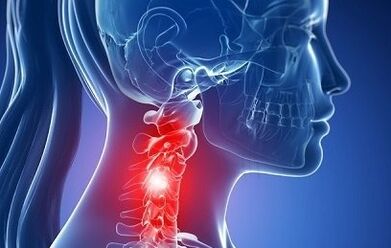
Only the team of good specialists, who includes a neurologist, a physiotherapist, a masseur, a surgeon, a vertebroneurologist, can choose the most suitable therapy.
Medical physical education
LFK for cervical osteochondrosis must be carried out outside acute exacerbation.The greatest effectiveness of this technique during the recovery period.During the implementation of the complex, there should be no discomfort and pain!
- Exercise number 1Stay in this position for 1-2 minutes.Sink slowly on the floor.Repeat 2-3 times.
- Exercise number 2. Lie on the stomach, stretch your arms along the body, turn your head to the left, try to touch the floor with your ear, then turn your head to the right.Repeat 6-7 times in each direction.
- Exercise number 3. In a sitting position, lean forward and try to touch the chest with your head, then exhale, support and throw your head.Repeat 10-15 times.
- Exercise number 4. When sitting, put the palms of the forehead, put pressure on the palms of the forehead and the forehead is on the palm.This exercise continues for 30 seconds.Repeat 2-3 times.
- Exercise number 5. Slowly revolve the head first in one direction, then in the opposite direction.10 rotations in each direction.Make sure there are no dizziness.When it appears, the exercise stops.
Therapeutic massage
The massage can be performed at home, but very carefully so as not to cause exacerbation and not damage the patient.The patient must take the position of lying down, put his forehead on his hands and stretch his chin on his chest.In this case, the neck muscles should be completely relaxed.
- Caress.It is necessary to start the massage with these movements: caress the collar area in the direction of the lymph to the upper and axillary nodes.Then flat and creating shots are used.
- Squeeze.To perform the pressing, the masseur puts his hand on the neck (the index and the thumb should be together) and move along the spine.Streezing can also be performed by the edge of the palm of the shoulder joints.
- Shredding.The rubbings are performed to heat the muscles, relax and improve the bloodstream in this area.The massage should start from the base of the skull, performing with circular and direct movements of the fingers.You can also perform sawdust movements by setting the palms in parallel on the ribs.
- Kneading.The neck should be stunned in circular movements.
- Vibration.The massage is completed by stroking and vibrations, which is performed using brain commodities and shots.
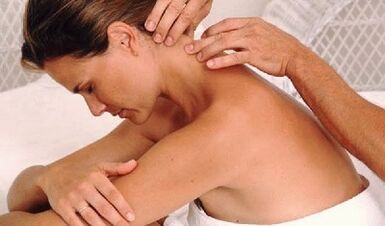
The massage is necessary to strengthen muscle tone and relieve pain.Depending on the phase it is osteochondrosis, the massage technique is selected.However, when they make neck massage, experts use all the techniques of classic massage: rubbing, caressing, kneading, etc.In cases where the patient hurts only on the one hand, the massage begins in the healthy part of the neck, gradually moving to that part of the collar area where pain occurs.
Manual therapy
Manual therapy helps to cope with acute and chronic pains, also increases the volume of movements and improves posture well.The main manual therapy techniques for osteochondosis of the cervical column:
- Relaxing and segmentary massage.It is used to heat the muscles and relieve tension.
- Mobilization.Impacts aimed at restoring joint functions for traction.
- Handling.A strong impulse aimed at the patient's pathological areas.The procedure is accompanied by a characteristic creaking (the return of the joint in a normal position).
A specialist who practices manual therapy must perfectly possess these techniques.Otherwise, any mistake can lead to injuries.
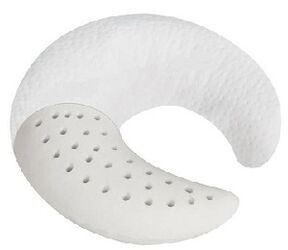
Orthopedic cushions
Orthopedic cushions to sleep are an effective means of prevention.In many cases, osteochondrosis is aggravated due to the additional transmission of the cervical artery and the nerve roots during sleep on a discomfort cushion.The orthopedic product provides a uniform horizontal position of a person during sleep and, therefore, guarantees the influx of physiologically full blood to the brain.
When choosing a pillow, the individual anatomical characteristics of a person should be taken into consideration and should be related to the volume and the characteristics of the filling.A adequately selected pillow brings tangible benefits to the patient with osteochondosis of the cervical column.
Physiotherapy
Physiotherapy procedures for osteochondosis of the cervical region:
- Electrophoresis.It should be used using anesthetics (anesthetics), which are introduced under the skin through electronic impulses.
- Ultrasound.The metabolic processes in the fabrics of the cervical region is favorably, due to which swelling, pain leaves is removed.
- Magnetotherapy.A safe treatment technique, which consists in the effect of damaged cells of a low frequency magnetic field.This gives an analgesic effect, acts as an anti -inflammatory agent.
- Laser therapy.It improves blood circulation in the damage area, relieves the swelling of the tissues, pain.
Physiotherapy procedures favorably influence records and vertebrae with cervical osteochondrosis.In combination with drugs, combined treatment helps to get rid of the symptoms of the disease.The procedures are performed in a hospital or offices specialized in clinics.Before starting the course, you need to consult a doctor, determine the duration of physiotherapy, the types.It is strictly forbidden to pass during the exacerbation.
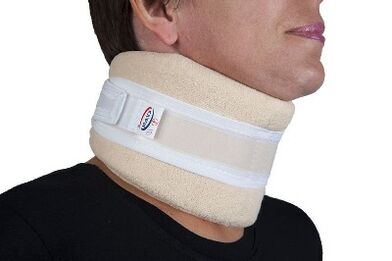
Collar shanza
The Shansa collar is a soft and convenient device, fix behind a velcro and used for cervical osteochondosis.But not for treatment, but for temporary relaxation and the removal of fatigue.It cannot be worn without removing, otherwise the neck muscles will stop working and soon atrophy.If a chantza collar is selected correctly, the patient feels comfortable and safe.
A collar is strictly selected in a pharmacy or in an orthopedic shop.Better in the shop, because the people who work there, as a rule, know their business well and the characterization of goods and, therefore, can help in any particular case.
Popular remedies
If the pain from the osteochondosis of the spine becomes unbearable and regular, then you will accept everything, even if only to stop it, and here the traditional complex treatment will successfully complete the popular methods.
- Insist the root of celery (5 gr. For 1 liter of boiling water) for 4 hours, drink a spoon before each meal;
- Compressed of honey, for which we take 2 teaspoons.honey and 1 compressed mummy.We heat the components in a water bath, spread on the fabric and apply to the cervical region, that is, the neck, at night;
- In acute pain, hell that grows in the country helps me.His sheet is simply mine, they start again with boiling water, cool me a little, I put it on the neck and hide it with a thin scarf at night - in the morning you can already live and work;
- We insist on the chamomile flowers in vegetable oil for two days, after heating up for a boil (30 ml of oil are needed for 30 grams of plants), rub in painful areas;
- The combination of the honey cart also helps, for this reason, the cultivation of the roots must be rubbed and mixed with honey in the same quantity, sticking to the sore neck at night, use it regularly, at least once a week.
Prevention
As usual, correct prevention will help to avoid osteochondosis of the cervical region, but, of course, all physical exercises should be used regularly, otherwise there will be not many benefits from "periodic" classes.
It remains to remember simple rules:
- Eat more products with a large amount of football and magnesium.These are fish, peas, legumes, nuts, cheese, vegetables, but from sugar, flour, smoked, acute it is better to refrain.
- Practice sports regularly, in particular swimming, aquaerobic, also to prevent osteochondrosis, gymnastics for stretching and flexibility of the vertebrae is suitable, which can be practiced at home.
- When sitting to work at least a couple of times a day, perform a special series of exercises.
- Choose a good orthopedic mattress and a pillow, perfect for the neck, supporting the head in a dream in the correct anatomical position (yes, your huge favorite cushions with problems with the spine do not pass!).
If you already have such a diagnosis, the patient must save the spine, that is to say:
- To be very attentive to the lifting and transport of weights, it is better to go to the shop twice rather than pull unbearable bags with both hands, incredibly stressing the flow of neck and shoulder;
- Not in excess, avoid drafts and cold air from the air conditioner (some love to cool on a hot day, becoming the back to the fan);
- When the body is tilt forward, the osteochondosis recalls;
- Avoid overheating of local muscles, which can happen among lovers of an excessively hot bath;
- Do not forget to periodically detach from the monitor, change the position of the body, do not sit for hours or even days;
- Rest in the neck, for which you need to buy a collar on board;
- If possible, if the state of the cardiovascular system allows steam in the bathroom.
In conclusion, I would like to say that the child who threatens the osteocondrosis (father and mother already has it) and an adult who has acquired the disease in the life process, simply must adopt preventive measures so as not to be disabled and not to be on the operational table, because this operation is quite complicated and requires a long rehabilitation.Furthermore, it is not always possible, because there are inoperable cases, so it is better to protect health with a young man, while the records are intact and unnecessary growths do not squeeze the blood vessels.



















